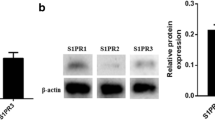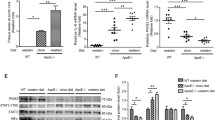Abstract
C1q/tumor necrosis factor-related protein-3 (CTRP3) is a novel, certified, adipokine that beneficially regulates metabolism and inflammation in the cardiovascular system. Atherosclerotic plaque rupturing and secondary thrombosis cause vascular disorders, such as myocardial infarction and unstable angina. However, the underlying role of CTRP3 in atherosclerosis remains unclear. In this study, we aimed to elucidate whether and how CTRP3 ameliorates inflammation and endothelial dysfunction caused by oxidized low-density lipoprotein (ox-LDL). We first confirmed that CTRP3 expression was inhibited in ApoE−/− mice, compared to normal mice. Then, pcDNA-CTRP3 and siCTRP3 were transfected into mouse aortic endothelial cells after ox-LDL stimulation, and we observed that enhanced CTRP3 remarkably downregulated CRP, TNF-α, IL-6, CD40, and CD40L. We also observed that overexpression of CTRP3 elevated cell activity and decreased lactated hydrogenase release, accompanied by a marked reduction in cell apoptosis induced by ox-LDL. Meanwhile, overexpressed CTRP3 caused a decrease in Ang II, ICAM-1, and VCAM-1 expression, and it restored the balance between ET-1 and NO. Mechanism analysis confirmed that incremental CTRP3 upregulated p-PI3K, p-Akt, and p-eNOS expression, indicating that CTRP3 facilitated activation of the PI3K/Akt/eNOS pathway. On the contrary, siCTRP3 exerted the opposite effect to this activation. Blocking these pathways using LY294002 or L-NAME attenuated the protective role of CTRP3. Overall, these results suggest that CTRP3 can efficiently inhibit the inflammatory response and endothelial dysfunction induced by ox-LDL in mouse aortic endothelial cells, perhaps by activating the PI3K/Akt/eNOS pathway, indicating a promising strategy against atherosclerosis.




Similar content being viewed by others
References
Guo, Y., X.C. Liu, Y.J. Wang, Q. Li, Q. Yang, X.G. Weng, Y. Chen, W.Y. Cai, X.X. Kan, and X. Chen. 2016. Effects of Shenlian extract on experimental atherosclerosis in ApoE-deficient mice based on ultrasound biomicroscopy. Bmc Complementary & Alternative Medicine 16: 469.
Badimon, L., and G. Vilahur. 2014. Thrombosis formation on atherosclerotic lesions and plaque rupture. Journal of Internal Medicine 276: 618–632.
Ragino, Y.I., A.M. Chernjavski, Y.V. Polonskaya, A.M. Volkov, E.V. Kashtanova, A.V. Tikhonov, and S.Y. Tcimbal. 2012. Oxidation and endothelial dysfunction biomarkers of atherosclerotic plaque instability. Studies of the vascular wall and blood. Bulletin of Experimental Biology & Medicine 153: 331–335.
Chong, D.P.H., and B.S. Bachenheimer. 2000. Current, new and future treatments in Dyslipidaemia and atherosclerosis. Drugs 60: 55–93.
Yoo, H.J., S.Y. Hwang, H.C. Hong, H.Y. Choi, S.J. Yang, S.C. Dong, S.H. Baik, M. Blüher, B.S. Youn, and K.M. Choi. 2013. Implication of progranulin and C1q/TNF-related protein-3 (CTRP3) on inflammation and atherosclerosis in subjects with or without metabolic syndrome. PLoS One 8: e55744.
Kim, J.Y., J.Y. Min, J.M. Baek, S.J. Ahn, H.Y. Jun, K.H. Yoon, M.K. Choi, M.S. Lee, and J. Oh. 2015. CTRP3 acts as a negative regulator of osteoclastogenesis through AMPK-c-Fos-NFATc1 signaling in vitro and RANKL-induced calvarial bone destruction in vivo. Bone 79: 242–251.
Sun, H., X. Zhu, Y. Zhou, W. Cai, and L. Qiu. 2017. C1q/TNF-related Protein-9 ameliorates ox-LDL-induced endothelial dysfunction via PGC-1α/AMPK-mediated antioxidant enzyme induction. International Journal of Molecular Sciences 18: 1097.
Yi, W., Y. Sun, Y. Yuan, W.B. Lau, Q. Zheng, X. Wang, Y. Wang, X. Shang, E. Gao, W.J. Koch, and X.L. Ma. 2012. C1q/tumor necrosis factor-related protein-3, a newly identified adipokine, is a novel antiapoptotic, proangiogenic, and cardioprotective molecule in the ischemic mouse heart. Circulation 125: 3159–3169.
Hofmann, C., N. Chen, F. Obermeier, G. Paul, C. Büchler, A. Kopp, W. Falk, and A. Schäffler. 2011. C1q/TNF-related Protein-3 (CTRP-3) is secreted by visceral adipose tissue and exerts antiinflammatory and antifibrotic effects in primary human colonic fibroblasts. Inflammatory Bowel Diseases 17: 2462–2471.
Schmid, A., A. Kopp, F. Hanses, T. Karrasch, and A. Schäffler. 2014. C1q/TNF-related protein-3 (CTRP-3) attenuates lipopolysaccharide (LPS)-induced systemic inflammation and adipose tissue Erk-1/-2 phosphorylation in mice in vivo. Biochemical & Biophysical Research Communications 452: 8–13.
Wang, Y., L. Tu, Y. Li, D. Chen, and S. Wang. 2016. Notoginsenoside R1 protects against neonatal cerebral hypoxic-ischemic injury through estrogen receptor-dependent activation of endoplasmic reticulum stress pathways. The Journal of Pharmacology and Experimental Therapeutics 357: 591–605.
Pende, A., A. Denegri. 2012. An anti-inflammatory approach in the therapeutic choices for the prevention of atherosclerotic events: InTech, 158–164.
Chang, Y., Q. Wu, T. Tian, L. Li, X. Guo, Z. Feng, J. Zhou, L. Zhang, S. Zhou, and G. Feng. 2015. The influence of SRPK1 on glioma apoptosis, metastasis, and angiogenesis through the PI3K/Akt signaling pathway under normoxia. Tumour Biology the Journal of the International Society for Oncodevelopmental Biology & Medicine 36: 6083–6093.
Ou, H.C., W.J. Lee, S.D. Lee, C.Y. Huang, T.H. Chiu, K.L. Tsai, W.C. Hsu, and W.H. Sheu. 2010. Ellagic acid protects endothelial cells from oxidized low-density lipoprotein-induced apoptosis by modulating the PI3K/Akt/eNOS pathway. Toxicology & Applied Pharmacology 248: 134–143.
Wygrecka, M., D. Zakrzewicz, B. Taborski, M. Didiasova, G. Kwapiszewska, K.T. Preissner, and P. Markart. 2012. TGF-Î21 induces tissue factor expression in human lung fibroblasts in a PI3K/JNK/Akt-dependent and AP-1-dependent manner. American Journal of Respiratory Cell & Molecular Biology 47: 614–627.
Xing, S.S., X.Y. Yang, T. Zheng, W.J. Li, D. Wu, J.Y. Chi, F. Bian, X.L. Bai, G.J. Wu, and Y.Z. Zhang. 2015. Salidroside improves endothelial function and alleviates atherosclerosis by activating a mitochondria-related AMPK/PI3K/Akt/eNOS pathway. 中国药理学通报 72: 141.
Li, T., D. Li, H. Xu, H. Zhang, D. Tang, and H. Cao. 2016. Wen-Xin decoction ameliorates vascular endothelium dysfunction via the PI3K/AKT/eNOS pathway in experimental atherosclerosis in rats. BMC Complementary and Alternative Medicine 16: 27.
Dong, R., W. Chen, W. Feng, C. Xia, D. Hu, Y. Zhang, Y. Yang, D.W. Wang, X. Xu, and L. Tu. 2015. Exogenous bradykinin inhibits tissue factor induction and deep vein thrombosis via activating the eNOS/phosphoinositide 3-kinase/Akt signaling pathway. Cellular Physiology and Biochemistry: International Journal of Experimental Cellular Physiology, Biochemistry, and Pharmacology 37: 1592–1606.
Deng, G., Y. Long, Y.R. Yu, and M.R. Li. 2010. Adiponectin directly improves endothelial dysfunction in obese rats through the AMPK-eNOS pathway. International Journal of Obesity 34: 165–171.
Feng, X., Y. Zhang, R. Xu, X. Xie, L. Tao, H. Gao, Y. Gao, Z. He, and H. Wang. 2010. Lipopolysaccharide up-regulates the expression of Fcalpha/mu receptor and promotes the binding of oxidized low-density lipoprotein and its IgM antibody complex to activated human macrophages. Atherosclerosis 208: 396–405.
Matsuura, E., F. Atzeni, P. Sarzi-Puttini, M. Turiel, L.R. Lopez, and M.T. Nurmohamed. 2014. Is atherosclerosis an autoimmune disease? BMC Medicine 12: 47.
Mitra, S., A. Deshmukh, R. Sachdeva, J. Lu, and J.L. Mehta. 2011. Oxidized low-density lipoprotein and atherosclerosis implications in antioxidant therapy. The American Journal of the Medical Sciences 342: 135–142.
Huang, Y., G. Wan, and J. Tao. 2017. C1q/TNF-related protein-3 exerts the chondroprotective effects in IL-1beta-treated SW1353 cells by regulating the FGFR1 signaling. Biomedicine & pharmacotherapy = Biomedecine & pharmacotherapie 85: 41–46.
Otani, M., S. Furukawa, S. Wakisaka, and T. Maeda. 2015. A novel adipokine C1q/TNF-related protein 3 is expressed in developing skeletal muscle and controls myoblast proliferation and differentiation. Molecular and Cellular Biochemistry 409: 271–282.
Zhou, B.Y., Y.L. Guo, N.Q. Wu, C.G. Zhu, Y. Gao, P. Qing, X.L. Li, Y. Wang, Q. Dong, G. Liu, R.X. Xu, C.J. Cui, J. Sun, and J.J. Li. 2017. Plasma big endothelin-1 levels at admission and future cardiovascular outcomes: A cohort study in patients with stable coronary artery disease. International Journal of Cardiology 230: 76–79.
Jr, W.T. 2007. Coronary atherosclerosis, low-density lipoproteins and markers of thrombosis, inflammation and endothelial dysfunction. International Journal of Angiology 16: 12.
Hua, S., C. Song, C.L. Geczy, S.B. Freedman, and P.K. Witting. 2009. A role for acute-phase serum amyloid a and high-density lipoprotein in oxidative stress, endothelial dysfunction and atherosclerosis. Redox Report Communications in Free Radical Research 14: 187–196.
Tedgui, A. 2011. The role of inflammation in atherothrombosis: Implications for clinical practice. Vascular Medicine 10: 45–53.
Kopp, A., M. Bala, C. Buechler, W. Falk, P. Gross, M. Neumeier, J. Schölmerich, and A. Schäffler. 2010. C1q/TNF-related protein-3 represents a novel and endogenous lipopolysaccharide antagonist of the adipose tissue. Endocrinology 151: 5267–5278.
Akiyama, H., S. Furukawa, S. Wakisaka, and T. Maeda. 2007. CTRP3/cartducin promotes proliferation and migration of endothelial cells. Molecular and Cellular Biochemistry 304: 243–248.
Mitra, S., T. Goyal, and J.L. Mehta. 2011. Oxidized LDL, LOX-1 and atherosclerosis. Cardiovascular Drugs and Therapy 25: 419–429.
Qiu, M.K., S.C. Wang, Y. Tang, C. Pan, Y. Wang, S.Q. Wang, Z.W. Quan, and J.M. Ou. 2017. Tim-3 inhibits low-density lipoprotein-induced atherogenic responses in human umbilical vein endothelial cells. Oncotarget 8: 61001–61010.
Nakashima, Y., E.W. Raines, A.S. Plump, J.L. Breslow, and R. Ross. 1998. Upregulation of VCAM-1 and ICAM-1 at atherosclerosis-prone sites on the endothelium in the ApoE-deficient mouse. Arteriosclerosis, Thrombosis, and Vascular Biology 18: 842–851.
Zhao, W., C. Wu, and X. Chen. 2016. Cryptotanshinone inhibits oxidized LDL-induced adhesion molecule expression via ROS dependent NF-kappaB pathways. Cell Adhesion & Migration 10: 248–258.
Kojda, G., and D. Harrison. 1999. Interactions between NO and reactive oxygen species: Pathophysiological importance in atherosclerosis, hypertension, diabetes and heart failure. Cardiovascular Research 43: 562–571.
MA, B., D. I, and L. JH. 2015. Salt, angiotensin II, superoxide, and Endothelial Function. Comprehensive Physiology 6: 215.
Daugherty, A., M.W. Manning, and L.A. Cassis. 2000. Angiotensin II promotes atherosclerotic lesions and aneurysms in apolipoprotein E-deficient mice. The Journal of Clinical Investigation 105: 1605–1612.
Suo, J., L. Zhao, J. Wang, Z. Zhu, H. Zhang, and R. Gao. 2015. Influenza virus aggravates the ox-LDL-induced apoptosis of human endothelial cells via promoting p53 signaling. Journal of Medical Virology 87: 1113–1123.
Ma, Z.G., Y.P. Yuan, S.C. Xu, W.Y. Wei, C.R. Xu, X. Zhang, Q.Q. Wu, H.H. Liao, J. Ni, and Q.Z. Tang. 2017. CTRP3 attenuates cardiac dysfunction, inflammation, oxidative stress and cell death in diabetic cardiomyopathy in rats. Diabetologia 60: 1126–1137.
Pant, S., A. Deshmukh, G.S. Gurumurthy, N.V. Pothineni, T.E. Watts, F. Romeo, and J.L. Mehta. 2014. Inflammation and atherosclerosis--revisited. Journal of Cardiovascular Pharmacology and Therapeutics 19: 170–178.
Farmer, J.A., and G. Torre-Amione. 2002. Atherosclerosis and inflammation. Current Atherosclerosis Reports 4: 92–98.
Steinberg, D. 1997. Lewis A. Conner Memorial Lecture. Oxidative modification of LDL and atherogenesis. Circulation 95: 1062–1071.
Trpkovic, A., I. Resanovic, J. Stanimirovic, D. Radak, S.A. Mousa, D. Cenic-Milosevic, D. Jevremovic, and E.R. Isenovic. 2015. Oxidized low-density lipoprotein as a biomarker of cardiovascular diseases. Critical Reviews in Clinical Laboratory Sciences 52: 70–85.
Wang, S.S., S.W. Hu, Q.H. Zhang, A.X. Xia, Z.X. Jiang, and X.M. Chen. 2015. Mesenchymal stem cells stabilize atherosclerotic vulnerable plaque by anti-inflammatory properties. PLoS One 10: e0136026.
Schönbeck, U., G.K. Sukhova, K. Shimizu, F. Mach, and P. Libby. 2000. Inhibition of CD40 signaling limits evolution of established atherosclerosis in mice. Proceedings of the National Academy of Sciences of the United States of America 97: 7458–7463.
Forstermann, U., and H. Li. 2011. Therapeutic effect of enhancing endothelial nitric oxide synthase (eNOS) expression and preventing eNOS uncoupling. British Journal of Pharmacology 164: 213–223.
Ning, W.H., and K. Zhao. 2013. Propionyl-L-carnitine induces eNOS activation and nitric oxide synthesis in endothelial cells via PI3 and Akt kinases. Vascular Pharmacology 59: 76–82.
Yao, Y., Y. Wang, Y. Zhang, and C. Liu. 2017. Klotho ameliorates oxidized low density lipoprotein (ox-LDL)-induced oxidative stress via regulating LOX-1 and PI3K/Akt/eNOS pathways. Lipids in Health and Disease 16: 77.
Garcia-Prieto, C.F., F. Hernandez-Nuno, D.D. Rio, G. Ruiz-Hurtado, I. Aranguez, M. Ruiz-Gayo, B. Somoza, and M.S. Fernandez-Alfonso. 2015. High-fat diet induces endothelial dysfunction through a down-regulation of the endothelial AMPK-PI3K-Akt-eNOS pathway. Molecular Nutrition & Food Research 59: 520–532.
Xing, S.S., X.Y. Yang, T. Zheng, W.J. Li, D. Wu, J.Y. Chi, F. Bian, X.L. Bai, G.J. Wu, Y.Z. Zhang, C.T. Zhang, Y.H. Zhang, Y.S. Li, and S. Jin. 2015. Salidroside improves endothelial function and alleviates atherosclerosis by activating a mitochondria-related AMPK/PI3K/Akt/eNOS pathway. Vascular Pharmacology 72: 141–152.
Author information
Authors and Affiliations
Corresponding author
Ethics declarations
Conflict of Interest
The authors declare that they have no competing interests.
Additional information
Publisher’s Note
Springer Nature remains neutral with regard to jurisdictional claims in published maps and institutional affiliations.
Rights and permissions
About this article
Cite this article
Chen, L., Qin, L., Liu, X. et al. CTRP3 Alleviates Ox-LDL–Induced Inflammatory Response and Endothelial Dysfunction in Mouse Aortic Endothelial Cells by Activating the PI3K/Akt/eNOS Pathway. Inflammation 42, 1350–1359 (2019). https://doi.org/10.1007/s10753-019-00996-1
Published:
Issue Date:
DOI: https://doi.org/10.1007/s10753-019-00996-1




